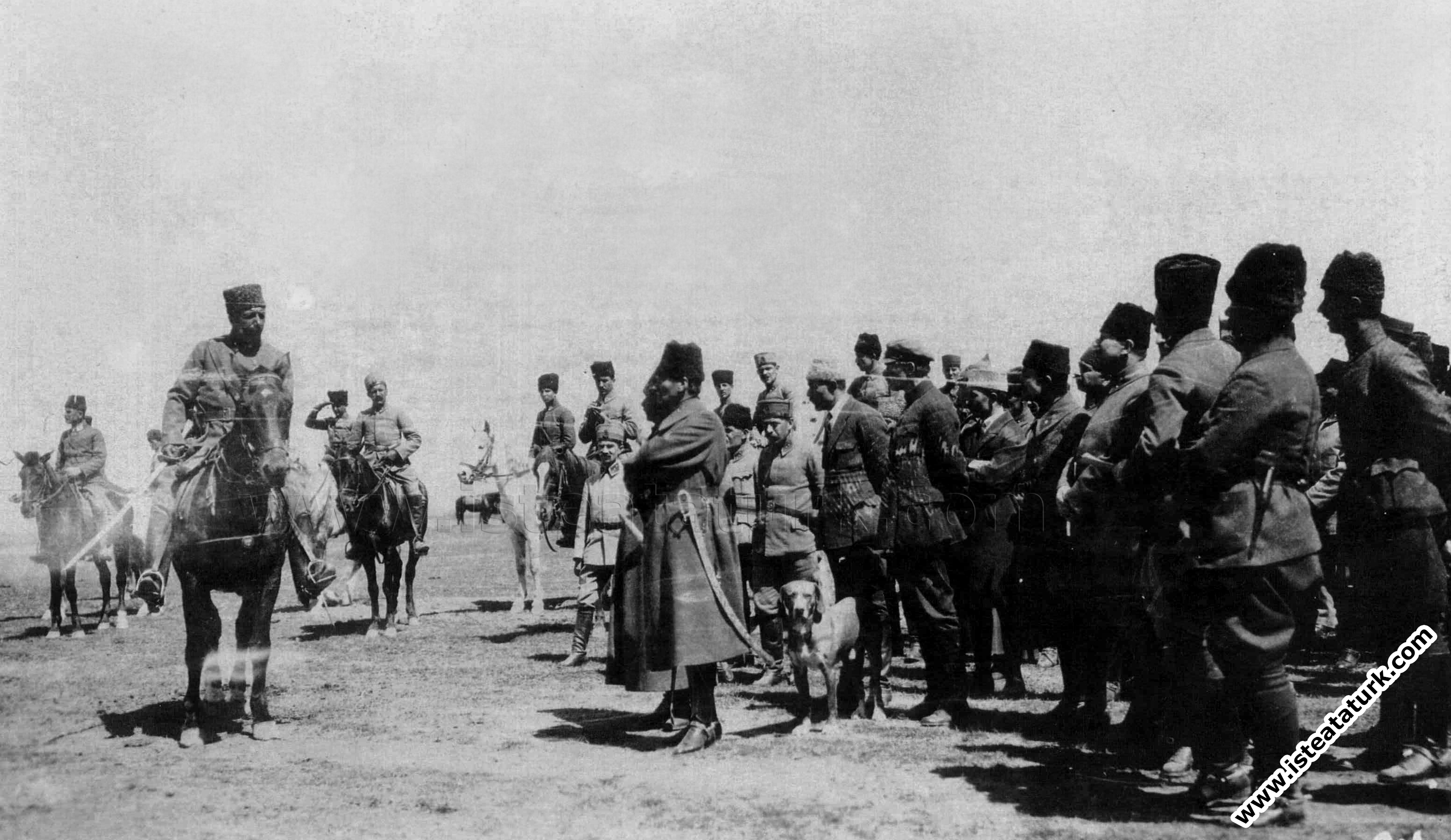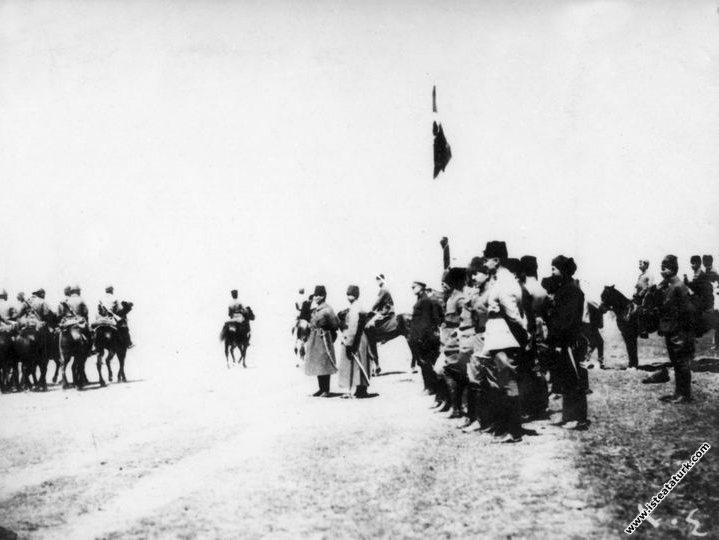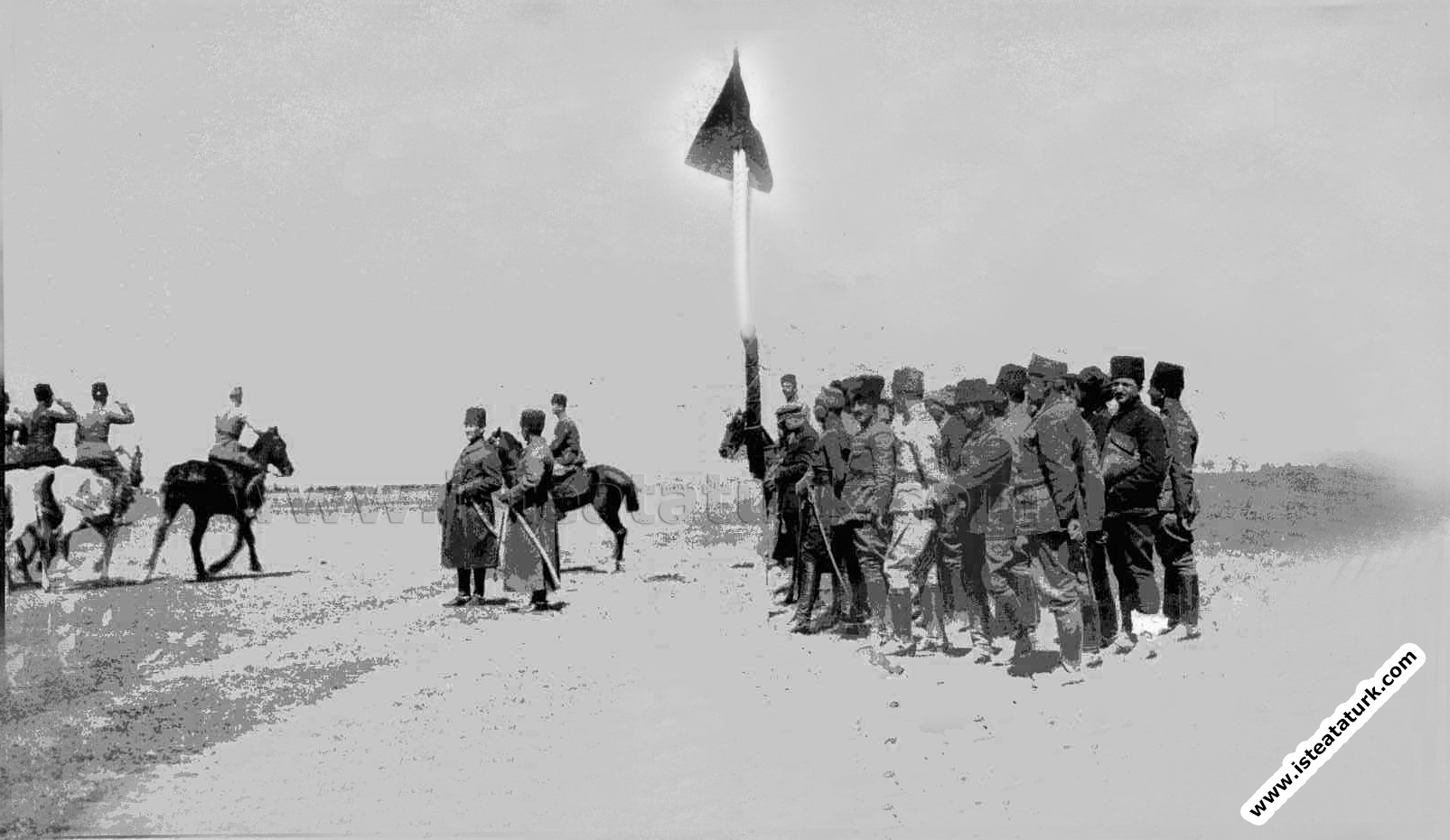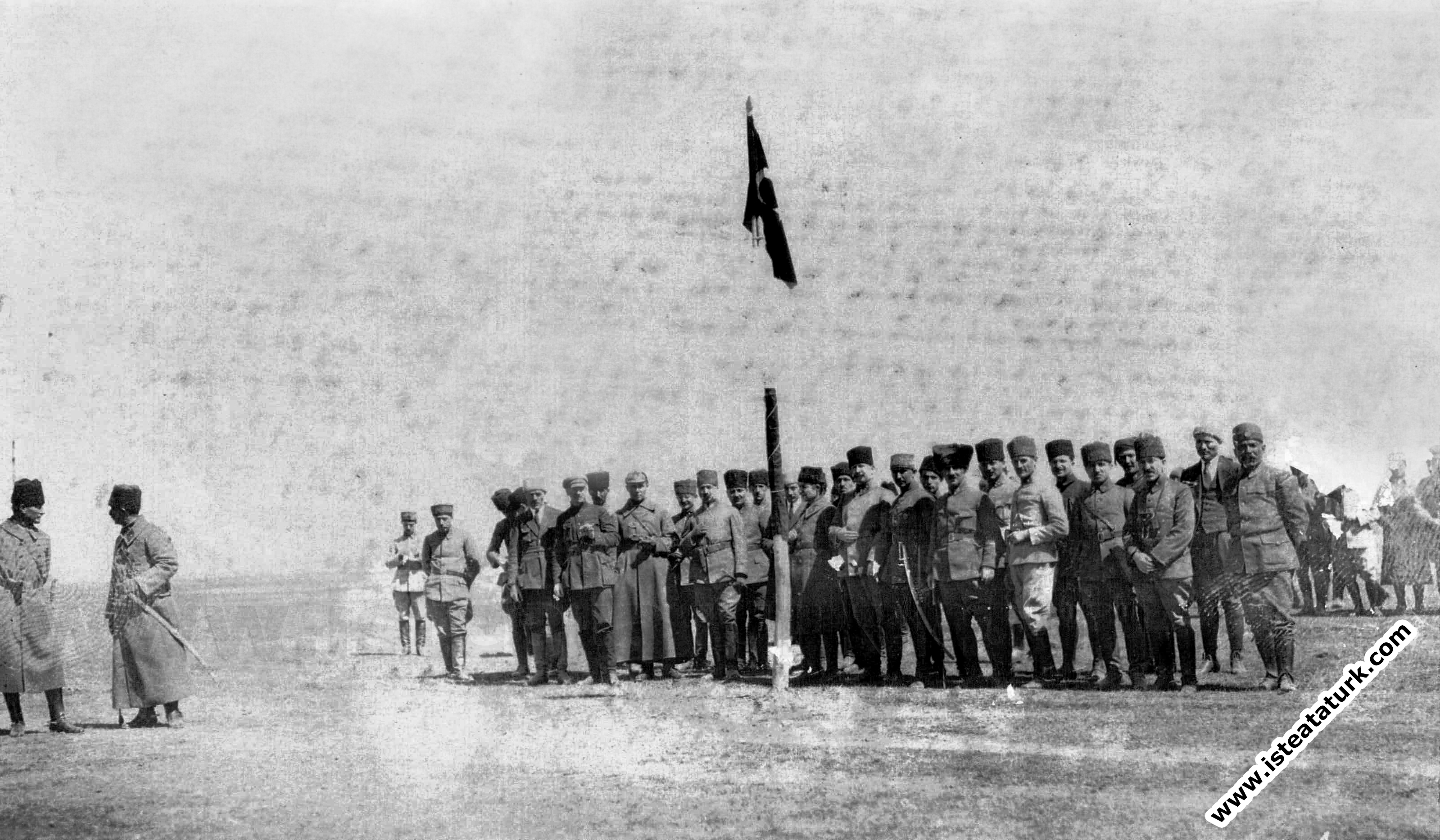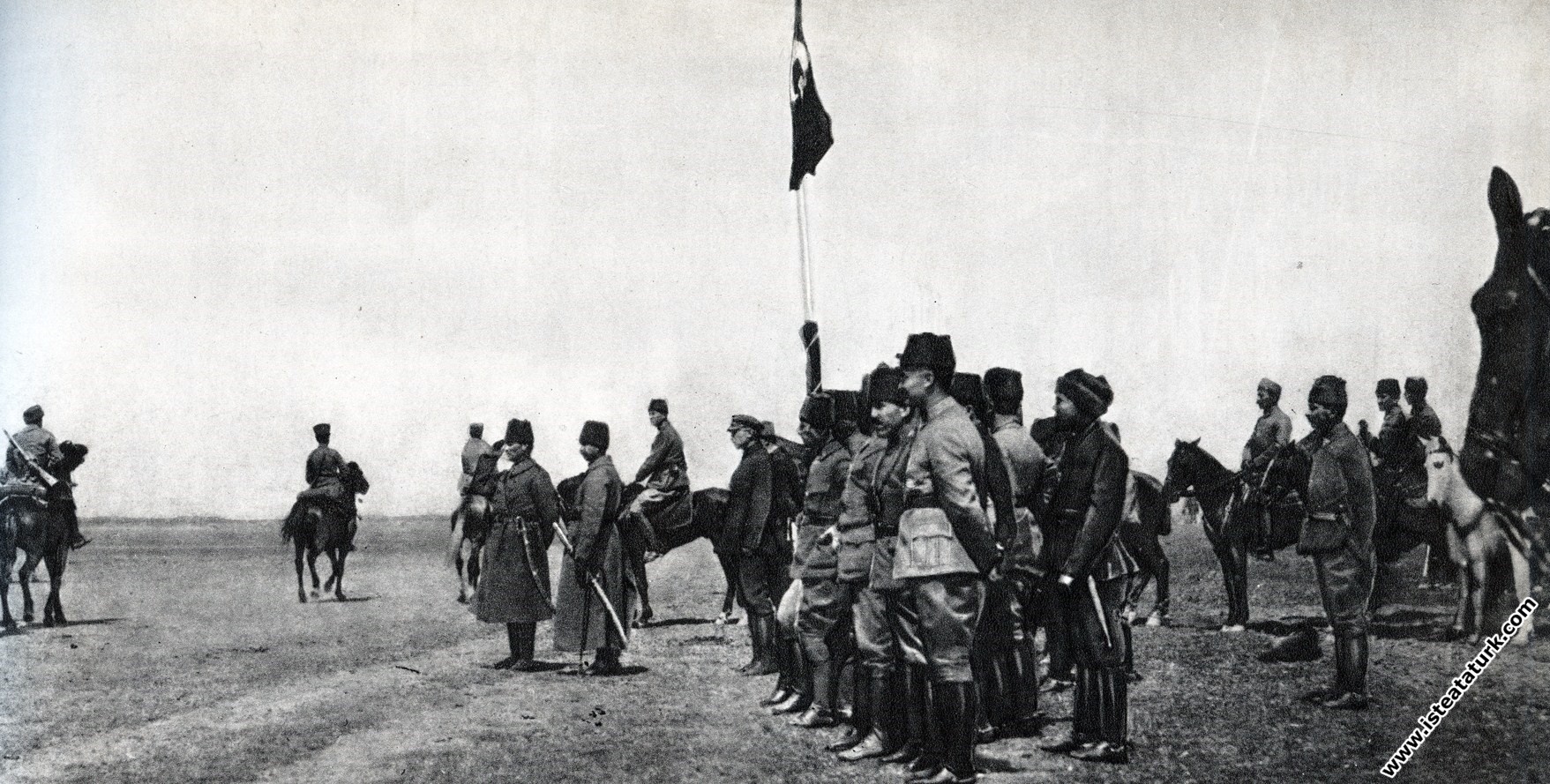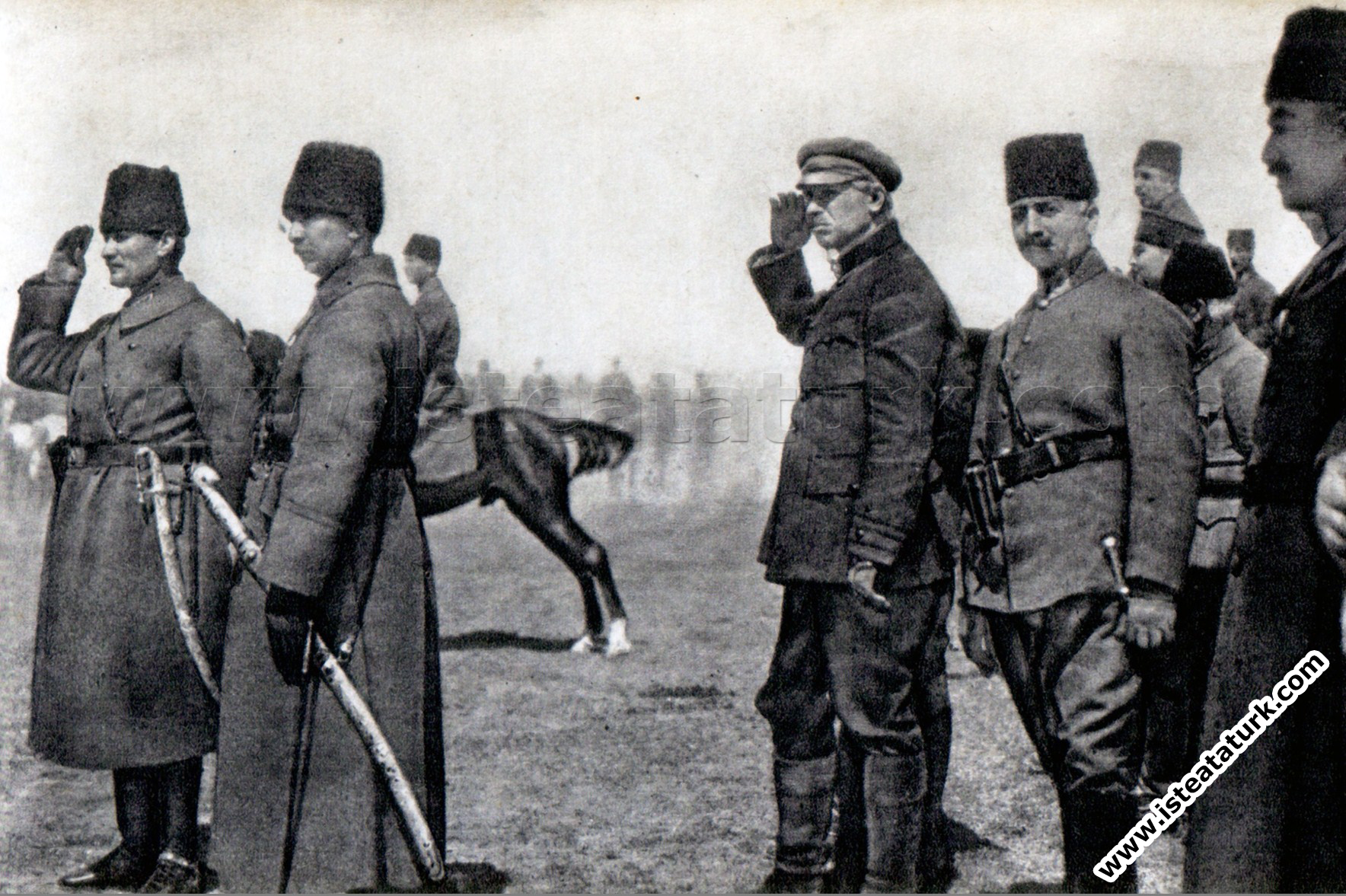Commander-in-Chief Gazi Mustafa Kemal Pasha supervises the preparations of the army before the Great Offensive at Ilgın Maneuvers. (01.04.1922)
Commander-in-Chief Gazi Mustafa Kemal Pasha supervises the preparations of the army before the Great Offensive at Ilgın Maneuvers. (April 1, 1922)
Mustafa Kemal Pasha's Inspection of the Soviet Russian and Azerbaijan Ambassadors and the 5th Cavalry Corps and their Visit to Ilgın
Mustafa Kemal Pasha, Soviet Russian Ambassador Aralov and Azerbaijani Ambassador Abilov and their military attachés made a visit and inspection of the front and back of the front covering Sivrihisar, Çay, Akşehir, Ilgın and Konya between 28 March and 4 April 1922. These visits and inspections, which were held at the invitation of Mustafa Kemal Pasha, are important in terms of showing the general condition and morale of the Turkish military units and the people to the Soviet ambassadors. Because, it has been fruitful in terms of placing their trust in the GNAT Government and military units on a more solid basis and ultimately receiving more Soviet military and financial aid (Guven, 2006, pp.58-60).
_%203(1).png)
The fact that the Western Front Headquarters is in Akşehir also brings with it the situation of the Turkish army units being deployed in and around this center. In this context, the 5th Cavalry Corps under the command of Fahrettin (Altay) Pasha, which constitutes an important element of the Turkish army, was stationed in Ilgın. Consisting of the 1st, 2nd and 14th Cavalry Divisions, this Corps was inspected together with its guests by the Speaker of the Grand National Assembly of Turkey and Commander-in-Chief Mustafa Kemal Pasha on April 1, 1922, within the scope of the above-mentioned front and rear visits and inspections, and then the district center was visited.
Visit of Mustafa Kemal Pasha I and His Guests to Ilgın
The day before the visit, an intense activity started in Ilgın as part of the preparations for the welcome. Hearing the news that Mustafa Kemal Pasha was coming to Ilgın caused great excitement among the people (Babalık, 4 April 1922, nr. 859, p.1).
Early on Saturday morning, April 1, 1922, the official buildings and shops were decorated with flags, and the people and masses of people rushed to welcome Ilgın. II. The fact that it coincided with the anniversary of the victory of the Battle of İnönü (March 30), increased the excitement and enthusiasm. Among the horsemen rushing here and there, at two o'clock in Turkish style, an enormous crowd of students and officials, children, women and men was advancing towards the reception area. Both sides of the Spa (Ilıca) Bridge took place in accordance with the previously prepared program, and everyone turned their eyes to the hill above the spa and waited with excitement (Babalık, April 4, 1922, nr. 859, p.1) 1 .
Finally, after waiting for a long time, the arrival of cars began to be seen from the slope towards five and six o'clock in Turkish style and the people started to rush from place to place with the desire to see Mustafa Kemal Pasha in his car (Babalık, 4 April 1922, nr. 859, p.1; Hâkimiyet-i Milliye, April 16, 1922, nr.483, p.1).
Following the official parade made by the military troops lined up to be ready for inspection, the maneuvers of the divisions were inspected (Babalık, 4 April 1922, nr. 859, p.1; Hâkimiyet-i Milliye, 16 April 1922, nr.483, p.1). goods have been made. This issue will be addressed in the next section. After the inspection, it was directed to the meeting place of the people.
Mustafa Kemal Pasha, who set off from the Western Front Headquarters Akşehir and reached Ilgın, was accompanied by İsmet Pasha, Russian Ambassador Aralov, Attaché Zvanayov (Zvonaryev), Embassy Clerk İsmailov, translator Feyzi, Azerbaijani Ambassador Abilov and Attaché Askerov, First Secretary İsmailov, Chief Adjutant. Salih, Companion Officer Major Mahmut, Captain Hilmi, Adjutant Muzaffer, and Clerk Memduh Bey. Mustafa Kemal Pasha, along with his entourage, walked towards the people waiting on the other side of the bridge in the reception area, complimented the officials and officials, while standing in front of the little students running to the welcome route, "How are you, little ladies and gentlemen? "He took their hearts by saying, and then asked about the memories of the people. Afterwards, they got into the cars and rested for a while directly in the flat allocated to their residence (Babalık, 4 April 1922, nr. 859, p.1; Hâkimiyet-i Milliye, 16 April 1922, nr.483, p.1).
_10.png)
In honor of Mustafa Kemal Pasha and his guests, a lunch banquet for forty people was given by Ilgın Municipality in the same private flat (Babalık, 4 April 1922, nr. 859, p.1)2. Later, Mustafa Kemal Pasha accepted the government officials and officials and the notables of the town through District Governor İbnülrefik Emin Bey, asked about their state and memories and took their hearts (Babalık, 4 April 1922, nr. 859, p.1; Hâkimiyet-i Milliye, 16 April 1922, nr. .483, p.1).
Mustafa Kemal Pasha and his guests with an enthusiastic farewell ceremony towards ten o'clock in Turkish style (Fathership, 4 April 1922, nr. 859, p.1; Hâkimiyet-i Milliye, 16 April 1922, nr.483, p.1) by train from Ilgın to Konya. They left to go to. In his memoirs, Aralov states that they bid farewell to İsmet Pasha cordially and remained loyal to the Pasha's tradition of not straying too far from the front, and despite all his requests, he was not willing to come to Konya with them (Aralov, 1985, p. 103) 3 .
II. Inspection of the Fifth Cavalry Corps (April 1, 1922)
When Mustafa Kemal approached, Fahrettin Pasha, the commander of the 5th Cavalry Corps, ran to the bare sword and gave the complete news. Here, riding horses were given to Mustafa Kemal Pasha and his companions (Aralov, 1985, p. 102).
With a previous order, the 5th Cavalry Corps, consisting of the 1st, 2nd and 14th cavalry divisions, arrived at the hot spring square.had been collected. It was inspected by the Commander-in-Chief Mustafa Kemal Pasha and Front Commander İsmet Pasha, and with a small maneuver, a parade was formally built. They were accompanied by the Soviet Russian ambassador S. İ. Aralov, the Azerbaijani ambassador Ibrahim Abilov and the military attaches of both embassies were present in this maneuver, and the rapid deployment of the horsemen was quite imposing. The official parade, in which a few thousand horsemen galloped, excited everyone and expressed satisfaction (Altay, 1970, p.316; Altay, 1949, p.38)5.

After the official parade and a small maneuver, Mustafa Kemal Pasha gathered the regiments and made the following speech: “Soldiers… The war is now laughing at us. We defeat the Greeks sent by the British to be slaughtered. The British imperialists want to destroy us, but they will not succeed. The Turkish people and the Turkish army have entered the war for their independence and will drive their enemies out of their holy land. The ambassador of the Soviet Union is also here with us” (Aralov, 1985, p. 102).
After these words, he asked the Soviet Ambassador Aralov to make a speech. Thereupon, Aralov in his speech on horse 6 ; He started his words by saying "valiant and noble soldiers" and said that he had brought the greetings of the Red army soldiers. In the meantime, Mustafa Kemal Pasha said something to Fahrettin Pasha, and when he waved his hand, the cavalrymen said, "Long live" in honor of the Red Army.they shouted. Aralov continued his words as follows: “… Russian workers and peasants are establishing a new state by taking power in their hands. My dear friends, I wish you to defeat the enemies of the new Turkey, save your beloved homeland, and take back the cities of Izmir and Istanbul. The Red Army believes that with your noble behavior you will bring honor to the army and independent Turkey”. This speech was interrupted with the words "Live" again, and Fahrettin Pasha asked General Budyonny to convey his greetings (Aralov, 1985, p. 103) 7.
Aralov, who participated in the inspection of the infantry in Afyon Çay two days ago, gives the following sentences in his memoir: “ The appearance of the cavalry was much more vivid than the infantry. His attire was plain monotonous. Almost all of them had boots on their feet. The horses are fine, but individually in frosts.” It is also understood that the Soviet delegation was informed about the total strength of the 5th Cavalry Corps. As a matter of fact, he states that the number of Aralov Corps is 6,000 swords and 8,000 horses, including artillery and machine gunners. These figures are close to the information given by Fahrettin Altay (Aralov, 1985, p. 102) 8.
_%20%2013%20(3)(1).png)
In his memoirs, Fahrettin Pasha explains that Mustafa Kemal Pasha did not understand why he brought the ambassadors with him at first, and that he learned the reason later: “Although the Russians were our friends at that time, we could not understand the purpose of showing them the front forces. We learned much later that the Russians offered us a joint war and for this purpose they wanted to land troops in Zonguldak, Ereğli and fight together in Kocaeli. They claimed that our forces would not be enough to drive the enemies out of Istanbul. Wouldn't it be possible for Mustafa Kemal to not understand the hidden purpose in this? (...) He immediately said: 'My strength is enough to save both Izmir and Istanbul' and organized this trip with their envoys and attachés to show this fact.”Fahrettin Pasha reports that he heard the Russians' joint war offer from Lieutenant General Baki Vandemir, who was a staff at the general headquarters at that time (Altay, 1970, pp.316-317).
Mustafa Kemal Pasha recorded the following information and thoughts in his notebook after the inspection (Türkmen, 2004, p.214, 220) 9:
“April 1, 1338 (1922), There were changes in the way the cavalry participated in the war due to the use and application of new vehicles and new ordinary laws. But this change does not change the essence of the task undertaken by the cavalry. It is the most important task of the cavalry to be fast enough and to give great agility to the maneuver.”
“The cavalry is a defensive tool before the war, and an offensive tool after the war. Fire is one of the most important and distinctive features of cavalry warfare. In the past, the results were drawn from decisive and difficult positional battles. Today the force is in the fire. We inspected the cavalry corps in Ilgın. We reached Konya in the evening. At 7.30 we were greeted enthusiastically.”
Indeed, with the Great Offensive, in a short period of fourteen days, with the great contribution of the Turkish cavalry units, the Greek occupation forces were driven from Anatolia.
The inspection of the 5th Cavalry Corps, which was stationed in Ilgın and carrying out the preparations for the offensive, by the Commander-in-Chief and his guests at a time when the soldiers and the people needed morale and the on-site determination of the situation, and the visit to the district center are important in terms of the history of the National Struggle.
Fahrettin Altay Pasha proudly narrates the events that took place in the inspection in his works. Our cavalry units, which put trust in friends and fear in the enemy, played an important role in getting the final result in the Great Offensive. In this process, the Greek infantry and cavalry units never dared to confront the Turkish cavalry units.
The most important problem on the eve of the Great Offensive is to meet the financial and military needs of the army. The financial and military aid received from Soviet Russia during the National Struggle was of great value. It is important to show the Soviet ambassadors that the Turkish army continues its preparations for the offensive and that if sufficient support is provided, a final result can be achieved. It can be said that the inspection of the 5th Cavalry Corps and the visit to the district center in Ilgın on April 1, within the scope of the front and rear visits and inspections carried out between 28 March and 4 April 1922, contributed to the mentioned issue.
1 Fahrettin Pasha writes in his memoir that they arrived on 1 March. There is a printing error. See. (Altay, 1970, p.316).
2 The menu includes: Decent soup, roast lamb, fresh broad beans, pastry, dessert, rice and fruit. See. (Father, April 4, 1922, nr. 859, p.1).
3 In his memoirs, Fahrettin Pasha informs us that they went to inspect the infantry in Akşehir as a false information. See. (Altay, 1970, p.316).
As stated above, they went to Konya. İsmet Pasha returned to his headquarters in Akşehir. See. (Önder, 1998, p.318).
4 The name of the region where the maneuver is made is “Big Meadow”. See. (Ali Boran et al., 2011, p.51).
5“… Every officer and soldier who passed in front of Atatürk in this parade picture, the energy and feelings of pride he received from the eyes of the sky shining with appreciation and hope became the sanction of our future victory. They were kind enough to give me an old silver-plated sword, which was seen hanging around Atatürk's neck in the photographs of that parade and was a gift from the Azerbaijanis. I am proud to leave this sword as a heirloom to all future Altays, just like my surname, which was given by him.” See. (Altay, 1949, p.38). “In the parade painting, the silver-embroidered antique sword hanging on Gazi Mustafa Kemal's waist was presented to him by the people of Azerbaijan. Later, Atatürk also kindly gave me this sword in the first years of the Republic. Now, when I look at the sword that is always in front of my eyes at my house, I seem to see the lights of hope shining in Mustafa Kemal's eyes as the cavalry units pass.” See. (Altay, 1970, p.317).
6 Aralov also records the following in his memoir: “I don't know if I'm sitting on the saddle correctly according to the riding rules. But my horse stood at ease. All eyes turned to me. I had Abilov with me.” See. (Aralov, 1985, p.103). In his memoirs, Aralov records that Fahrettin Pasha was a competent and brave cavalryman and that the Turks compared him to the Russian General Budyonny
. See. (Aralov, 1985, p. 103).
In his memoir, Aralov incorrectly writes Fahrettin Pasha's name as “Fahri”. See. (Aralov, 1985, p. 102).
Semyon Mikhailovich Budyonny, who is of Kazakh origin, is a famous cavalry commander who took an active role in the Red Army.
8It gives the following information about the existence of Fahrettin Pasha Corps: The Fifth Cavalry Corps consists of the 1st, 2nd and 14th Cavalry Divisions. Total: 550 Officers, 9900 Privates, 9480 Animals, 6450 Rifles, 48 Machine Guns, 4800 Swords, 620 Bombs and 16 Mountain Cannons. This power does not include the Mobile Hospital, Animal Hospital and Transport Branches. See. (Altay, 1949, p.39).
9 The article in the cited reference deals with the Inspection of the Great Cavalry Maneuver on April 15, 1922. However, in some parts of the article, it is seen that it was confused with the events that took place during the inspection and visit dated April 1, 1922.
Source: Cemal Güven, Uluslararası Toplum Araştırmaları Dergisi, Yıl:7 Cilt:7 Sayı:13, Aralık 2017, ISSN:2528-9527 E-ISSN : 2528-9535
